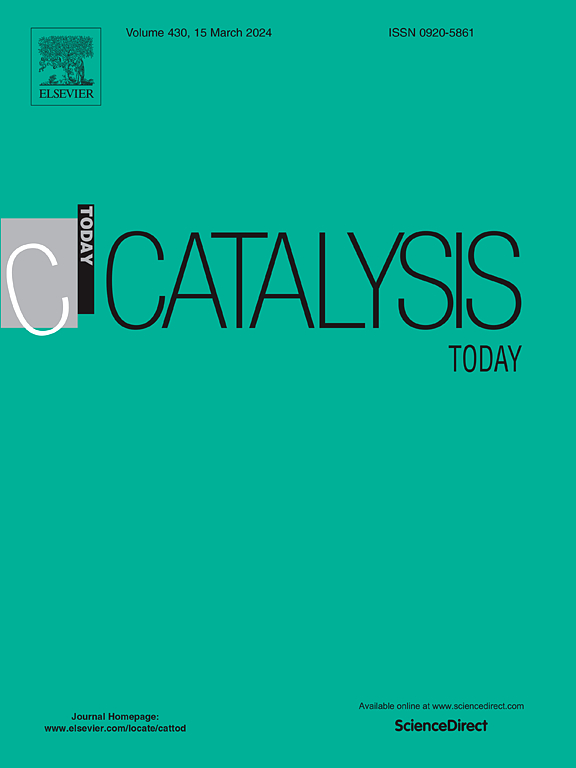Experimental study and statistical analysis of hydrogen yield in methane steam reforming over a hydroxyapatite-supported nickel catalyst
IF 5.2
2区 化学
Q1 CHEMISTRY, APPLIED
引用次数: 0
Abstract
This study aimed to investigate the use of hydroxyapatite (HAp) as a catalyst support for the methane steam reforming (MSR) process. Catalysts were prepared via incipient wetness impregnation using nickel as the active metal and characterized by N2 physisorption analysis, X-ray diffraction, H2 temperature-programmed reduction, and transmission electron microscopy. The effects of four key parameters in hydrogen production—nickel loading (Ni wt%), inlet steam-to-methane (H2O/CH4) ratio, space velocity (SV), and temperature (T)—were evaluated via a statistical analysis. Thermodynamic calculations were also used to compare the catalyst activity results with the equilibrium conditions. The findings confirmed the effectiveness and stability of HAp as a support, exhibiting high thermal stability, coke resistance, and a mesoporous structure with an average specific surface area of 65 m2·g−1. The calcined Ni/HAp catalyst mainly comprised crystalline NiO and displayed a higher surface area of 54 m2·g−1 and superior dispersion at loadings of 5 and 10 wt% Ni compared to 15 wt% Ni. The temperature, SV, and inlet reactant ratio significantly influenced the process. A long-term stability test carried out under optimal conditions over 98 h demonstrated the consistent activity and stability of the 10 wt%Ni/HAp catalyst, maintaining a high methane conversion of 99 % and yielding 90 % hydrogen, 80 % carbon monoxide, and 20 % carbon dioxide, with no observed carbon deposition on the catalyst surface.
羟基磷灰石负载镍催化剂甲烷蒸汽重整产氢率的实验研究与统计分析
本研究旨在探讨羟基磷灰石(HAp)作为甲烷蒸汽重整(MSR)过程催化剂载体的应用。以镍为活性金属,采用初湿浸渍法制备了催化剂,并通过N2物理吸附分析、x射线衍射、H2程序升温还原和透射电镜对催化剂进行了表征。通过统计分析评估了四个关键参数对制氢的影响:镍负载(Ni wt%)、进口蒸汽与甲烷(H2O/CH4)比、空速(SV)和温度(T)。热力学计算也用于比较催化剂活性结果与平衡条件。研究结果证实了HAp作为载体的有效性和稳定性,具有较高的热稳定性、抗焦性和平均比表面积为65 m2·g−1的介孔结构。煅烧后的Ni/HAp催化剂主要由结晶NiO组成,其表面积为54 m2·g−1,在5和10 wt% Ni的负载下,其分散性优于15 wt% Ni。温度、SV和入口反应物比对该过程有显著影响。在98 h以上的最佳条件下进行的长期稳定性测试表明,10 wt%Ni/HAp催化剂的活性和稳定性保持一致,甲烷转化率为99 %,氢气转化率为90 %,一氧化碳转化率为80 %,二氧化碳转化率为20 %,催化剂表面没有观察到碳沉积。
本文章由计算机程序翻译,如有差异,请以英文原文为准。
求助全文
约1分钟内获得全文
求助全文
来源期刊

Catalysis Today
化学-工程:化工
CiteScore
11.50
自引率
3.80%
发文量
573
审稿时长
2.9 months
期刊介绍:
Catalysis Today focuses on the rapid publication of original invited papers devoted to currently important topics in catalysis and related subjects. The journal only publishes special issues (Proposing a Catalysis Today Special Issue), each of which is supervised by Guest Editors who recruit individual papers and oversee the peer review process. Catalysis Today offers researchers in the field of catalysis in-depth overviews of topical issues.
Both fundamental and applied aspects of catalysis are covered. Subjects such as catalysis of immobilized organometallic and biocatalytic systems are welcome. Subjects related to catalysis such as experimental techniques, adsorption, process technology, synthesis, in situ characterization, computational, theoretical modeling, imaging and others are included if there is a clear relationship to catalysis.
 求助内容:
求助内容: 应助结果提醒方式:
应助结果提醒方式:


